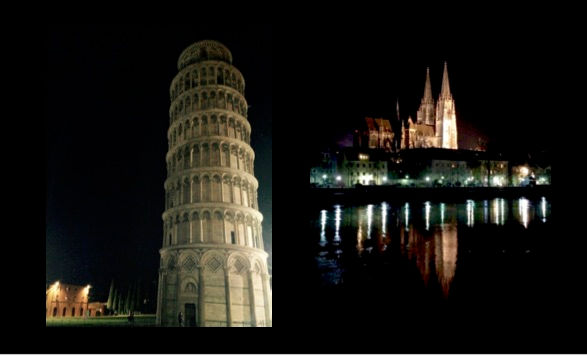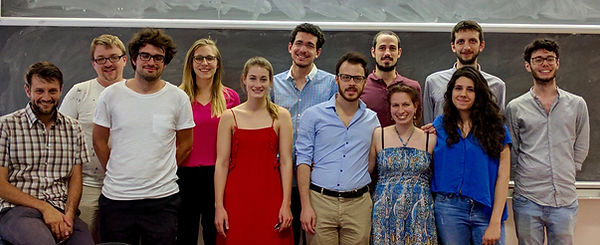Alessandra Pluda
Workshop
"From Regensburg to Pisa: two days of Analysis under the Leaning Tower"
June 30th, July 1st 2017, Università di Pisa
Co-organized with Valerio Pagliari

Christopher Brand - Universität Regensburg -
The Helfrich Flow with evolving spontaneous curvature
The gradient flow of an the Helfrich energy that measures the L^2 deviation of the mean curvature
of a submanifold from a prescribed spontanuous curvature has been studied intensively in recent years.
In our model, the spontanuous curvature is induced by a vectorfield on the submanifold, that evolves itself under the regime of a Dirichlet-type energy.
The resulting flow can be regarded as a coupling between the Helfrich flow and the harmonic map heat flow.
Since the symbol of the linearizeation is not homogenous, solving the linear equation requires some additional effort.
As the flow is of fourth order, we cannot use a maximum principle and the analysis of possible singularities
and long-time behavior relies on integral estimates.
Julia Butz - Universität Regensburg -
Short time existence for Curve Diffusion Flow for curves with boundary contact
In non-linear PDEs it is always desirable to be able to find strong solutions even if the initial regularity is low, as this gives insights in smoothing properties of the system and helps to provide good blow-up criteria.
In this contribution, we obtain local well-posedness for flexible initial data in H^4(μ−1/2 )(I), μ ∈ (7/8,1]
in the case of evolving curves driven by curve diffusion flow.
This is done for curves which intersect an external boundary at a fixed angle α ∈ (0, π).
In order to reduce the geometric evolution equation to a quasilinear fourth order PDE on an interval,
we use curvilinear coordinates. To establish local well-posedness for this equation and to deal with the rough initial data, we have to work in a setting of temporally weighted Lp-spaces.
Giovanni Eugenio Comi - SNS Pisa -
Anisotropic surface measures as limits of volume fractions
We consider the new characterization of the perimeter of a measurable set in Rn recently studied by Ambrosio, Bourgain, Brezis and Figalli. We modify their approach by using, instead of cubes, covering families made by translations of a given open bounded set with Lipschitz boundary. By adapting the argument of the proof of the differentiation theorem for measures to nondecreasing superadditive or subadditive set functionals, we show that the functionals defined through the new coverings converge to an anisotropic surface measure. Such a measure is a multiple of the perimeter if we allow for isotropic coverings (e.g. balls or arbitrary rotations of the given set).
Giacomo Del Nin - Università di Pisa -
Asymptotic planar N-bubbles
We consider in the plane a fixed finite number N of "bubbles", that is disjoint finite perimeter sets
which possibly share portions of their boundaries, and look for configurations that minimize, under a volume constraint, the total weighted length of their boundaries: the interface between each bubble and the exterior is given weight 1 while the interface between any two bubbles is given weight 2 - ε. We are interested in the case when ε converges to 0: in this case minimizing configurations approach in the limit a configuration of disjoint disks, and the weighted perimeter of minimizing configurations, suitably rescaled, is related to the number of contacts among the disks in the limit configuration.
This is an ongoing research work with Giovanni Alberti.
Luigi Forcella - SNS Pisa -
Energy scattering for a class of 1D NLS perturbed with a steplike potential.
In this talk I will provide to the audience an introduction to the Concentration/Compactenss & Rigidity method developed by Kenig and Merle in order to study scattering for the energy critical NLW equation and NLS equation. Due to the broad mathematical context I also recall the tools of Strichartz estimates and then
I will sketch how to use these techniques to analyze scattering for the NLS equation perturbed with a steplike potential. If time permits, I will also give the idea behind the proof in a more general context, namely in higher dimensional framework and allowing periodic potentials in all but one variable. This is a joint work with N. Visciglia (University of Pisa).
Marta Leocata - Università di Pisa -
A particle system approach to cell-cell adhesion
In this talk I will present a model for cellular adhesion based on a system of PDE and I will investigate a microscopic derivation, proving that the empirical measure converges to the solution of the system of PDE. Description of local interaction is given by the notion of moderate interactions in the sense of K. Oelshchlager.
Julia Menzel - Universität Regensburg -
Short time existence of a variant of the Willmore Flow for surface with fixed boundary
and Navier boundary conditions
The Willmore energy of a surface in R3 given by the squared L2-norm of its mean curvature is of great
interest in geometry. While the behaviour of closed surfaces is well understood, there are only few results on evolution problems with boundary conditions.
We consider a generalized Willmore–type energy involving the Gaussian curvature of the surface and consider the gradient flow of this energy under the constraint that the boundary stays unchanged.
The Navier boundary condition turns out to be the natural boundary condition to this problem.
In my talk I present the techniques to prove short time existence of the evolution problem in a Sobolev Setting.
Federico Stra - SNS Pisa -
Linear extensions through random projection
We construct a regular random projection of a metric space onto a closed subset and use
it to linearly extend Lipschitz functions. This technique provides an explicit construction of the extendability result by Lee and Naor and let us also extend C^1 functions in the style of Whitney.
